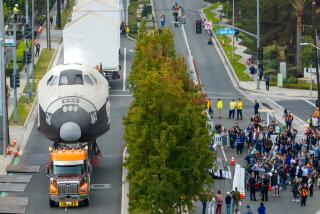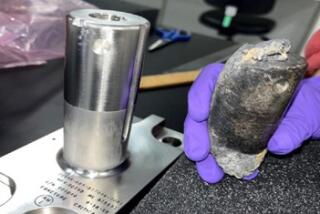Shuttle Columbia’s Debris on View at NASA Facility
- Share via
CAPE CANAVERAL, Fla. — NASA allowed reporters to see debris from the space shuttle Columbia in its final resting place Friday, a space that is part shrine and part laboratory.
The viewing of the depository here at Cape Canaveral, where the space agency launches its shuttles, took place ahead of the first anniversary of the tragedy on Sunday.
The 34,147 pounds of recovered shuttle pieces were neatly labeled and bar-coded and displayed or crated with a sense of order and composure that contrasts sharply with the violent demise of the United States’ oldest shuttle craft.
Columbia broke apart in the skies over Texas on Feb. 1, 2003, killing all seven astronauts aboard. The shuttle had damaged a wing during lift-off 16 days earlier.
Converted office space inside the mammoth Vehicle Assembly Building, where the shuttles begin their long, slow roll-out to the launch pad, was chosen as the depository for the debris.
Some of the pieces are instantly recognizable.
The shuttle’s forward window frames survived the disaster, though only fragments of the windows themselves survived. A hatch door and a complete landing gear, with four fairly intact tires beside it, were also on view.
“Columbia was a great ship,” said Michael Leinbach, launch director for the shuttle program. “We like to call this the Arlington Cemetery for Columbia.”
The United States has buried its honored war veterans at Arlington National Cemetery since the Civil War. A memorial service at Arlington for Columbia astronauts is being held Monday.
The remains of NASA’s earlier flight disaster, the Challenger, lost just after its launch 18 years ago, were buried in an abandoned missile silo, but NASA decided the Columbia debris still had a useful purpose.
So far, NASA said, about 20 research institutions, mostly universities, have expressed interest in studying the shuttle debris.
Although satellites routinely are destroyed in the atmosphere, the cost of collecting the debris has always prevented materials scientists from studying how various components react to the intense heat and kinetic energy of reentry.
Some Columbia parts, especially the wing panels that failed in the accident, are being studied at different NASA centers as part of the space agency’s effort to return the three remaining shuttles to flight status.
The remains of the crew compartment are kept in a room apart from the rest of the debris. Because the seven astronauts died on those two decks, approval from the Astronaut Office would be required before the release of those materials, NASA said.
More to Read
Sign up for Essential California
The most important California stories and recommendations in your inbox every morning.
You may occasionally receive promotional content from the Los Angeles Times.










